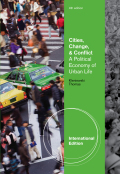
CITIES, CHANGE, AND CONFLICT - A POLITICAL ECONOMY OF URBAN LIFE, International Edition discusses the importance of cities for the economic, cultural, andpolitical life of modern societies. The authors consistently use the political economy perspective to introduce students to the basic concepts and researchin urban sociology, while also acknowledging the contributions of the human ecology perspective. Through the use of case studies, the presentation remains accessible and down-to-earth, engaging the student in the material. INDICE: Preface. PART I: THINKING ABOUT CITIES. 1. Examining Urban Issues.Attitudes About Cities. Box 1.1 The City as a Magnet for Youth. Some Urban Myths. Political Economy Perspective. Cities, Change, and Conflict: Three Applications. The Forbidden City Within Los Angeles. Criminalizing Homelessness. Box1.2 Project HOME''s Campaign against Homelessness. Environmental Racism and Environmental Justice. Box 1.3 Environmental Justice in Chicago. Conclusion. 2.Theoretical Perspectives on the City. Theories and Paradigms. Urban Ecology Paradigm. Antecedents: Tonnies, Durkheim, Simmel. The Chicago School. Contributions and Critique. Political Economy Paradigm. Antecedents: Marx, Engels, and Weber. Emergence of Urban Political Economy. Promise and Limitations of Political Economy. Box 2.1 Perspectives on Urban Ghettos. Conclusion. PART II: THE CHANGING CITY: HISTORICAL AND COMPARATIVE PERSPECTIVES. 3. Cities in World History. Origins of Cities. Early Urban Centers. What Makes Them Cities? Ancient Cities, 1000 B.C. to A.D. 300. Physical Features of Ancient Cities. Social Patterns in Ancient Cities. Cities Outside of Europe. Cities of the Near East. Box3.1 Islamic Cities. Cities of the Far East. Box 3.2 Chinese Cities of the Chou Dynasty. Cities of the Americas. Box 3.3 City Planning in Teotihuacán. Medieval Cities in Europe. Feudalism and the Growth of Towns. Social Institutions. Pressures on the System. Growth of Capitalism and the Industrial City. Cities Built on Trade. World-Economy. Early Industrial Cities. Conclusion. 4. Urban Development in the United States. A Brief History of Cities of the United States. The Commercial City. The Industrial City. The Corporate City. Explaining Urban Patterns. Ecological Explanations. Political Economic Explanations. Process of Urban Growth and Change. City Builders: Property Capitalists. Local Government Officials. Corporations. Regional Differences in Growth and Development.The South. New England. California. Conclusion. 5. Cities, Suburbs, and Metropolitan Areas. Changes in Metropolitan Areas Since 1950. Growth of Suburbs andMetropolitan Areas. Policy Choices by the Federal Government. Local PoliticalChoices: To Annex of Not to Annex? Corporate Decisions: New Industrial Spaces. Social Consequences of Suburbanization. Restructuring the Central Cities. Transformation of the Central Business Districts. Social Transformation of the Cities. Box 5.1 The Process of Gentrification in New York''s East Village. Box 5.2 Restructuring of the Metropolitan Los Angeles Economy. Explaining Urban Transformations. The United States in the World Economy. Government Responses toEconomic Changes. Conclusion. 6. Cities in Europe. Cities in Western Europe. Box 6.1 Super Cities. Comparisons with North American Cities. Factors Affecting Western European Cities. Emerging Problems in Western European Cities. Immigration. Socially Excluded Groups. Cities in Eastern and Central Europe. Urban Planning. Box 6.2 Planning for Moscow as a Communist Mecca. Box 6.3 The International Scene in Prague. Housing. Economic Restructuring. Environmental Challenges. Globalization and Global Cities. The Process of Globalization. Globalization and Politics. Global Cities. Characteristics of Global Cities. Similarities among Global Cities. Conclusion. 7. Cities in the Third World. Characteristics of Third World Cities. Urban Population Trends. Box 7.1 The Urban-Rural Gap. Economic and Political Trends. Box 7.2 The Informal Sector in Calcutta. Box7.3 Mexico City. Explaining the Diverging Paths of Urban Development. Development Perspective. Uneven Development Perspectives. Box 7.4 The Banana Industryand the Honduran Economy. Box 7.5 Caribbean Sweatshops. Future Development ofThird World Cities. Conclusion. PART III: CHANGE AND CONFLICT: URBAN SOCIAL GROUPS. 8. Immigrants and the City. Old and New Immigration. Three Waves of Immigration. Reactions to Newcomers. Economics of Immigration. U.S. Immigrations Policy. Contemporary Immigrant Lifestyles. Ethnic Identification and Group Solidarity. Box 8.1 The Méndez Children. Ethnic Neighborhoods and Ethnic Enclaves. Immigrants in the Workplace. Immigrants and Politics. Do Cities Gain or Losefrom Immigration? Conclusion. 9. African Americans in Cities. Development of African-American Neighborhoods. Urban Race Relations Before the Great Migration. Box 9.1 Race Relations in Philadelphia Before 1900. The Great Migration. Whites and Segregation. Enclave or Ghetto? Current Racial Patterns in Metropolitan Areas. Institutional Barriers to Housing Choice. Correlates and Consequences of Racial Segregation. Suburban Movement. Social Class Patterns in African-American Neighborhoods. Changing Class Structure. Racial Concentration and Political Power. Box 9.2 Geography of Race and Social Class in Detroit. Current Issues Around Race and Residential Patterns. Government Policy. Attitudes About Racial Homogeneity. Conclusion. Discussion Questions. Online Exercises. 10. Changing Social Class Patterns. What Is a Social Class? Social Class and Communities. Mapping Studies: Pictures of the Whole City. Descriptions of Urban Life:Community Studies. Box 10.1 Creation of an Elite Neighborhood. Box 10.2 Dismantling of a Working Class Community. Summary. Mechanisms for Sorting Out the Social Classes. Housing Market. Institutional Actors and Influences. Labor Market. The Changing Economy and the Shrinking Middle Class. Housing Patterns: A Reflection of Social Inequality. Withdrawal of the Affluent. Displacement of the Vulnerable. Homelessness: The Bottom of the Barrel. Conclusion. Discussion Questions. Online Exercises. 11. Women in Cities. Women''s Spaces, Men''s Spaces. Gender, Ethnicity, and Social Class in the City. Gendered Urban Spaces. Contemporary Workplaces. Transportation. Community Organizations. Box 11.1 Women as Community Activists. Recreation. Consumption. Running Cities As If Women Mattered. What Do Women Want? User-Friendly Communities. Discussi
- ISBN: 978-0-8400-3271-3
- Editorial: Wadsworth
- Encuadernacion: Rústica
- Páginas: 448
- Fecha Publicación: 23/04/2010
- Nº Volúmenes: 1
- Idioma: Inglés
